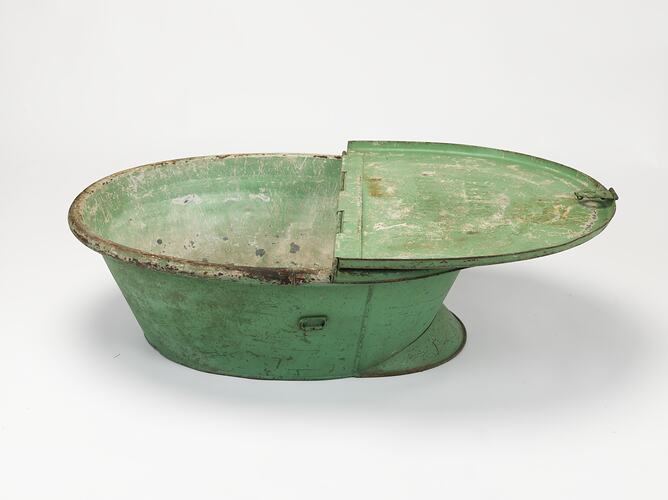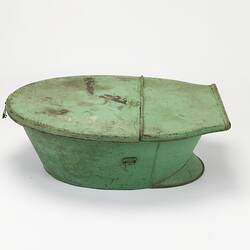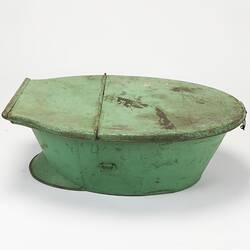The travel bath was brought to Australia in 1853 by immigrants John Francis Davies (aged 53, c.1800-1875) and his wife Maria Bele (aged 52, c.1800-1876) with their three daughters, Martha Jane (aged 18, c.1834-1889), Emily Eleanor (aged 13, 1838- c.1929) and Maria (aged 11, 1840-c.1929). Martha Jane was accompanied by her husband William Piper Brown (26), whom she had recently married at St Pauls Church, Shadwell. Travelling aboard the sailing ship 'Appleton', the family departed London on 15th December, 1852 and four months later in April 1853 they arrived in Melbourne.
When migrating to Australia, John brought many of his household objects, including various family artefacts, all their furniture, silk paintings and the travel bath. Initially, he rented in Prahran, but he and his family later moved to the corner of High Street East and Kent Street, Prahran (recorded in the 1857 rate book as a wooden shop and four-roomed cottage). Later the cottage was replaced with a pre-fabricated iron house which remained until the early 1940s. In England, John had owned his own factory manufacturing shoes in Shoreditch, London. However, according to early Sands and McDougall directories John Davies was referred to as a merchant and at other times a boot manufacturer. He died in Prahran on 31st March, 1875 and was buried in the St Kilda area.
Emily Eleanor (1838-c.1929), the Davies family's middle child, told her own children and grandchildren the stories of her voyage to Australia and life in Prahran. She recalled the bath being brought out from England, and the bath's use for bathing and as a lockable storage place. She remembered bathing in the travel bath as a little girl in their Prahran home. This is an object which has passed through several generations, and the donor's family recalls the bath from around the1920s as being a functional everyday object for family bathing. According to Lawrence Wright, baths from around 1850 usually "required the exterior to be plain brown, and the interior imitation marble. The finish did not stand up very long against wear and hot water, and the repainting of the bath was, until the fairly recent introduction of porcelain enamels, a regular and seldom successful operation." This customary habit would account for the bath's current green painted surface, which is almost certainly a later addition; the donor recalls this green surface from the 1920s, and believes that frequent usage and time required the subsequent re-paint.
References: Lawrence Wright. Clean and decent: the history of the bath and loo and of sundry habits, fashions & accessories of the toilet, principally in Great Britain, France & America. London; Boston: Routledge & Keagan Paul, 1960 Rev. 1980.
More Information
-
Keywords
-
Authors
-
Article types


